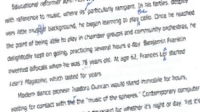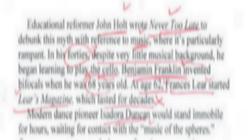| |
Finding Hidden Markets for Magazine Articles
by Marcia Yudkin
When I hold up the current Writer's Market in my workshop for beginning writers and tell them that every year I read it cover to cover, there are always gasps of astonishment in the room. Every year during this read-through exercise I discover markets I want to investigate listed under categories I might not normally explore.
|
For those who are serious about making a living as a writer, though,
Writer's Market provides only a starting point. Tens of thousands of other magazines and non-magazine freelance markets exist. By consulting other directories, reading ads, chatting up editors and other writers and keeping your eyes open everywhere, you'll remain one jump ahead of the pack, writing for markets other freelancers learn about later
- or never.
Probably the easiest way to begin going beyond Writer's Market is to head to the library in your area that carries
Bacon's Directory of Magazines. This huge green paperbound volume,
aimed at public relations professionals, belongs to a set that also includes volumes on Newspapers, Radio and TV.
|
|
Published! How to
Reach Writing Success
|
|
Listings in
Bacon's provide all the contact information you'd want, circulation figures, names of editors and a brief profile of the readers and contents. With magazines categorized by subject and cross-referenced, you simply look up the topic on which you're looking for markets to discover additional titles.
Business school libraries and large public libraries may also carry
Standard Rate and Data Service. SRDS, as it's known in the advertising business, comes out monthly in about two dozen volumes and provides, among other information useful to advertisers, capsule profiles of thousands of consumer and trade magazines along with their circulation figures, ad rates, contact information, editors' names and sometimes a breakdown of subscribers in different categories and the annual editorial calendar.
These hidden markets may very well be worth your time. In 1997 I received a call from a magazine on graphic design listed in Bacon's but not
Writer's Market that had received a press release from me. The editor said she wasn't interested in the topic of my press release, but did I write articles? I had six nicely paid assignments from her in 1997 and 1998, all with long deadlines and requiring no research. I fit them in whenever other business slowed down.
|
Become a Successful Freelance
Writer - Start Today!
Slash your learning curve by completing nine
article idea generation and writing assignments
and gaining feedback from a Book-of-the-Month Club
author who has published in the New York Times
Magazine, Business
2.0, Psychology Today, USAirways, TWA Ambassador
and many other top publications. Magazine
writing course for beginners. |
Another strategy for finding magazines not known to most freelancers is seeking out new periodicals.
Folio magazine, carried in some big- city libraries, offers half a dozen or so mini-profiles of new magazines in each issue, including editors' names and addresses. Other articles and notes cover trends in the magazine business, pending sales and editorial changes, perhaps alerting you to interesting freelance possibilities.
Mediaweek, a sister publication of
Adweek, also includes notices about new publications and commentary on trends in magazine genres.
The Utne Reader, which anthologizes articles from the alternative press, broadly conceived, contains the names and addresses of many offbeat and new magazines, both in its editorial copy and in paid listings of publications looking for readers.
Several times a year, Boston-area freelancer Fawn Fitter takes a $20 bill with her to the Out of Town News stand at Harvard Square and spends it on intriguing magazines she's never seen or heard of. I've discovered new magazines at trade shows, at the seafood counter in the supermarket, in free pickup boxes, through charter-member solicitations in my mail, in friends' bathrooms and
- my favorite - in the airport when getting off the New York/Boston shuttle, where 40 or more diverse magazines sit in stacks free for the taking.
Ads of various sorts can tip you off to publications still in the launch phase. My first freelance piece appeared in the first issue of a supplement of the Sunday
New York Times after a tiny filler ad in the paper alerted me to its upcoming existence. Veteran reporter and newspaper editor Rick Friedman of Woburn, Massachusetts, got off to a smashing start as a freelancer by finding help-wanted ads from magazines he'd never heard of and sending in his clips and a cover letter.
|
Ready for the World's Top
Magazine Assignments?
If you have impressive clips and a track
record writing solid stories but can't crack
top markets, you need the advanced
"Breaking Into Major Magazines"
course. Discover the factors that make the
difference between just-okay, publishable
writing and the kind that gets published in Smithsonian,
National Geographic, Outside, Atlantic
Monthly and other glossies.
Advanced magazine
writing course.
|
Caitlin Kelly of Tarrytown, New York, says she goes out on job interviews several times a year partly to see if any magazine staff jobs out there can outshine the freedom of being a freelancer (so far, no) and partly to get face to face with editors. "Several times when I did not get the job they clearly could see my credentials and after an interview knew me a lot better than through some resume over the transom. I have found out about new markets and immediately had an 'in' that others did not have."
Even without going on job interviews, getting chummy with editors sometimes yields the dividend of finding out about new or obscure markets before the rest of the freelance world. When Barb Freda sold the second freelance piece she'd ever written to
Louisville Magazine, she mentioned her first sale, to
Chile Pepper, to the editor. "How did you happen to sell to a food magazine?" the editor asked her. Freda explained that she'd been a chef for ten years, whereupon the editor revealed that he also edited a food trade magazine called
Pizza Today. Since then, Freda has sold almost 40 articles to that magazine, which she might not otherwise have known about.
"The fact I'd written so much for
Pizza Today," Freda adds, "led to a good assignment with yet another obscure trade magazine called
QSR: Quick Service Restaurants (on fast food), a magazine that calls me frequently, with an editor who takes my pitches over the phone and almost always green lights my ideas."
Something similar happened to Caitlin Kelly. Talking to an editor at
Men's Journal who had rejected one of her ideas, she learned that he'd just become executive editor of a new magazine called
National Geographic Adventure. "Now I know it exists, its address, frequency, needs, and the names and numbers of two editors. It's in my specialty area, but since it's still in the hiring phase, it isn't on the newsstand or in any directory," Kelly says.
Clearly, schmoozing with editors rather than sticking strictly to business can result in opportunities. The same goes for schmoozing with other writers. Both Fawn Fitter and Caitlin Kelly have learned about obscure magazines or startups from other writers. Fitter got the chance to write for a new magazine called
Knowledge Management when its editor contacted someone who didn't have the time to take on another assignment.
"The other writer and I both host online forums," Fitter says, "and we know each other's work." Similarly, "Someone on the Journalism Forum on CompuServe alerted me to
Women Outside, though they're not assigning right now," notes Kelly.
Online networking with writers makes it especially easy to find out about obscure but appealing markets in other countries. Roberta Jacobson, based near Frankfurt, Germany, developed an
email friendship with a writer in England. The two shared leads and mailed each other a grab-bag of local magazines. "The latest batch of publications from England included
Old Glory, a British magazine about steam engines and restored trains," says Jacobson. "I'd sold First North American Serial Rights on my old German tram story, and was ready to find a market to 'unload' First British Serial Rights.
"Additionally," says Jacobson, "I had told my e-pal about being accepted in the new
Bride Again in the States and that they needed honeymoon articles about Egypt. He just happened to have one done that he was trying to sell, submitted it, and we'll both be in the premiere issue in April 1999."
Finally, non-magazine markets for freelance articles abound if you keep your eyes open and remember that wherever you see a long stretch of text, some writer and very possibly a freelancer got paid to produce it. New York City writer Jim Morrison found a market when he received a call from the editor of the program for the Seattle Mariners, asking to reprint a piece he wrote for
Southwest Spirit on the making of a Louisville Slugger bat. "I got off the phone and, boing, I realized there were 29 other teams, all with programs."
 |
Improve Your
Proofreading
Quick online course teaches how to
catch pesky typos. Whether you check
writing on screen or on paper, learn the
stakes for error-ridden copy, the five
best proofreading methods and the tools
you can or shouldn't use to identify
errors. Includes practice tests and
answers.
Proofreading Hacks course. |
A letter and clips Morrison sent to the Yankees won him an assignment to write about Derek Jeter for the World Series program. Although the pay didn't match what he usually makes per article, he figures he got paid to watch the Yankees play and hang out in the clubhouse and on the field before games.
Boston writer Lin Nulman found a similar hidden market during the course of volunteering for a theater company. When she realized that the organization published a study guide for each play it produced, she contacted the publications manager and offered to do one. "As a former English major, this gave me a chance to use my skills in research and putting things together in an interesting way," she says. Nulman wrote about 2,000 words on an early eighteenth-century French play for $800
- not bad, she considers, for her first freelance piece.
As for freelance articles in other kinds of non-magazines, I've seen some in catalogs such as Lands' End and at least one office-supply catalog. Newsletters that companies send to customers may need articles that resemble magazine service pieces or profiles. And last summer I helped the Australian publisher of home-study courses for writers revamp his material for Americans by commissioning articles from more than a dozen U.S. writers on their specialty areas. Many of us experienced writers, I think, could profitably follow in the footsteps of beginner Lin Nulman, who simply spotted an opportunity and asked.
Copyright 2005 Marcia Yudkin. All rights reserved.
|






